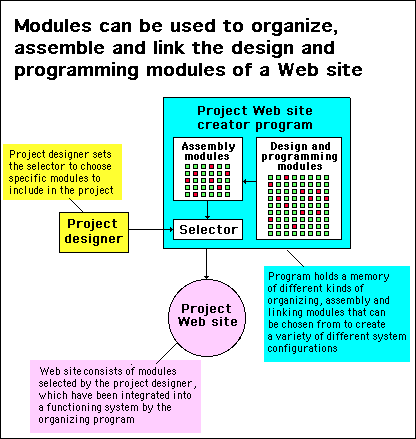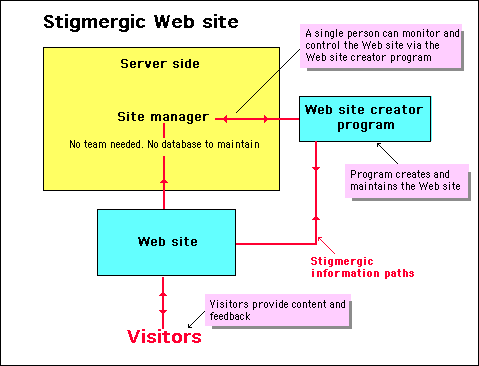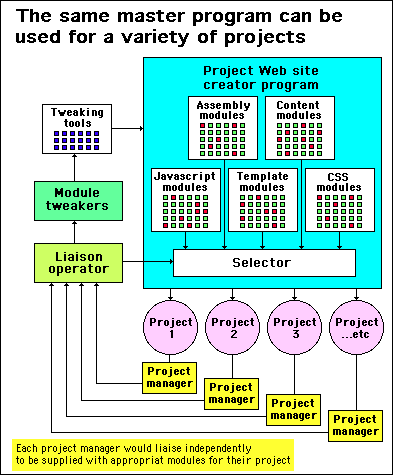

Designing for change
Auto assembly
Working with design and programming modules can still involve high development costs if it needs experts to be able to understand how the modules work and how they have to be linked together.
These costs can be largely eliminated if an extra class of modules are introduced - which can automatically assemble selected design elements together to produce complete Web sites.
By arranging to have a choice of these assembly modules, Web sites can be configured and reconfigured automatically, in different ways for different purposes.

Such a system will allow prototypes to be assembled, tested and experimented with - very quickly and cheaply - requiring the minimum of technical expertise. In other words, non technical people would be able to design and manipulate sophisticated projects without running up huge costs. This is illustrated in the following diagram.

Multiple use
Once you cotton on to the idea of a system consisting of modules of various kinds that can be selected from and quickly configured to create a new, up and running Web site, it becomes readily apparent that this system can serve many projects simultaneously. This is illustrated in the following diagram.

Project managers wouldn't have to worry about having to fund huge developments costs. It would simply be a question of deciding what the requirements of the project should be and ordering up the necessary features. Suitable modules can be brought together and a fully working prototype delivered almost immediately.
The delivered prototype can then be examined and tested - with only the tweaking of the module variables necessary to apply a wide variety of customization. Even quite large changes can be made, simply and immediately, by recreating the project with a different combination of modules.
Fast response to change
It is not only in the development phase where a Web site creator program would be beneficial. Perhaps even more importantly, it could handle the constant changes that are necessary to keep a site up to date and ahead of competition.
The diagram below illustrates how a project manager could single-handedly make adjustments to a site without the need to call upon a design team. This would greatly increase speed of response to changes and practically eliminate costs.

It also raises the possibility that a project manager may not needed at all. With a Web site creator program able to handle all the changes, the control of the Web site can be handed over to a sales or marketing manager, who would be able to manipulate the site to suit sales or marketing strategies.
How change is arranged
A master program that can autonomously create working Web sites, raises the question of how a project manager handles changes and further development.
The answer is surprisingly simple. The project manager simply specifies another prototype, which duplicates the Web site already in existence but is modified for required changes. The cost is minimal, because it involves nothing more than the substitution of different modules and the click of a button to create a fresh set of documents to make up a completely new version of the site.
The modified site wouldn't even have to replace the original, it can be run in parallel with previous versions so different versions can be compared directly.